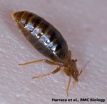(Press-News.org) September 9, 2010 – Malaria remains a serious global health problem, killing more than one million people per year. Treatment of the mosquito-borne illness relies on antibiotics, and the emergence of drug-resistant malaria is of growing concern. In a report published online today in Genome Research (www.genome.org), scientists analyzed the genomic features of a Peruvian parasite population, identifying the genetic basis for resistance to a common antibiotic and gaining new insights that could improve the efficacy of diagnosis and treatment strategies.
The World Health Organization began efforts to eliminate malaria in the mid-20th century and had made significant strides in curtailing the disease. However, by the 1990s, malaria was again on the rise due to the emergence of drug-resistant parasites, and today much remains unknown about the genetic basis of resistance.
Researcher Elizabeth Winzeler of The Scripps Research Institute and colleagues from the United States and Peru expected that by using genomic methods to analyze the malaria-causing parasite Plasmodium falciparum in a geographic area where malaria had been previously eradicated and recently re-emerged, they could identify positively selected regions of the genome that contain genes underlying drug resistance.
Iquitos, a city in the Amazonian lowlands of Peru, was an ideal choice for studying the genomic features of drug resistance as malaria was eliminated there in the 1960s, but re-emerged in the 1990s. Using microarrays to scan the genome of P. falciparum isolated from 14 patients in Iquitos, Winzeler's group analyzed and compared genetic variation between the isolates, searching for selected regions.
"We were surprised to find that the parasite populations in Peru were much more homogeneous than expected," Winzeler said. The data suggested that the malaria parasites from Iquitos patients were closely related, with some patients harboring parasites that are nearly clones of each other.
Winzeler explained that although the high similarity of the parasite genomes hindered their efforts to identify regions under selection, their analysis uncovered critical findings that could have a significant impact on the diagnosis and treatment of malaria.
The team's data indicated that there is significant genetic instability in regions near the telomere, the repetitive DNA sequences that protects the ends of chromosomes from damage. Because a malaria rapid diagnostic test relies on detection of a protein encoded by a subtelomeric gene, use of these tests could result in missed diagnoses.
Furthermore, their work identified a gene that could change the course of treatment for some infected patients. A mutation was found in a non-coding RNA gene that the authors predicted would confer resistance to the antibiotic clindamycin, a lincosamide drug commonly administered in combination with quinine to treat pregnant women and infants for malaria in Peru. They then tested the Peruvian isolates for clindamycin sensitivity and confirmed that the parasites were resistant. "This was exciting as it was the first demonstrated case of clindamycin resistance," Winzeler said. "The data also show parasites could be resistant to related compounds, such as mirincamycin, that are under development."
Winzeler noted that although the geographic scope of clindamycin resistance must be examined further, this work strongly suggests that treating pregnant women and infants with clindamycin and similar antimalarial lincosamide drugs should be reconsidered. "Our findings emphasize the importance of placing new antimalarial compounds in the drug development pipeline," said Winzeler, "especially compounds with novel mechanisms of actions."
INFORMATION:
Scientists from The Scripps Research Institute (La Jolla, CA), the Genomics Institute of the Novartis Research Foundation (San Diego, CA), and the Naval Medical Research Center Detachment (Lima, Peru) contributed to this study.
This work was supported by the W.M. Keck Foundation, the National Institutes of Health, the Medicines for Malaria Venture, and the Wellcome Trust (UK).
Media contacts:
The authors are available for more information by contacting Mika Ono at the Office of Communications and Public Relations, The Scripps Research Institute (+1-858-784-2052; mikaono@scripps.edu).
Interested reporters may obtain copies of the manuscript from Peggy Calicchia, Editorial Secretary, Genome Research (calicchi@cshl.edu; +1-516-422-4012).
About the article:
The manuscript will be published online ahead of print on September 9, 2010. Its full citation is as follows:
Dharia NV, Plouffe D, Bopp SER, González-Páez GE, Lucas C, Salas C, Soberon V, Bursulaya B, Kochel TJ, Bacon DJ, Winzeler EA. Genome-scanning of Amazonian Plasmodium falciparum shows subtelomeric instability and clindamycin-resistant parasites. Genome Res doi:10.1101/gr.105163.110.
About Genome Research:
Launched in 1995, Genome Research (www.genome.org) is an international, continuously published, peer-reviewed journal that focuses on research that provides novel insights into the genome biology of all organisms, including advances in genomic medicine. Among the topics considered by the journal are genome structure and function, comparative genomics, molecular evolution, genome-scale quantitative and population genetics, proteomics, epigenomics, and systems biology. The journal also features exciting gene discoveries and reports of cutting-edge computational biology and high-throughput methodologies.
About Cold Spring Harbor Laboratory Press:
Cold Spring Harbor Laboratory is a private, nonprofit institution in New York that conducts research in cancer and other life sciences and has a variety of educational programs. Its Press, originating in 1933, is the largest of the Laboratory's five education divisions and is a publisher of books, journals, and electronic media for scientists, students, and the general public.
Genome Research issues press releases to highlight significant research studies that are published in the journal.
STANFORD, Calif. - Stanford University researchers have developed a revolutionary, non-invasive way of quickly predicting the future health of premature infants, an innovation that could better target specialized medical intervention and reduce health-care costs.
"What the PhysiScore does is open a new frontier," said Anna Penn, MD, PhD, an assistant professor of pediatrics at the School of Medicine and a neonatologist at Lucile Packard Children's Hospital. "The national push toward electronic medical records helped us create a tool to detect patterns not readily ...
Scientists at the Johns Hopkins Kimmel Cancer Center have identified two genes whose mutations appear to be linked to ovarian clear cell carcinoma, one of the most aggressive forms of ovarian cancer. Clear cell carcinoma is generally resistant to standard therapy.
In an article published online in the September 8 issue of Science Express, the researchers report that they found an average of 20 mutated genes per each ovarian clear cell cancer studied. Two of the genes were more commonly mutated among the samples: ARID1A, a gene whose product normally suppresses tumors; ...
Athens, GA—A new University of Georgia study published in the journal Nature has identified a critical enzyme that keeps traffic flowing in the right direction in the nervous system, and the finding could eventually lead to new treatments for conditions such as Alzheimer's and Parkinson's disease.
"There was no medical or any other applied science drive for this project; it was purely curiosity about how transport inside cells works," said study co-author Jacek Gaertig, professor in the cellular biology department in the UGA Franklin College of Arts and Sciences. "But ...
New York, NY (September 8, 2010) – Dendritic cells are the grand sentinels of the immune system, standing guard 24/7 to detect foreign invaders such as viruses and bacteria, and bring news of the invasion to other immune cells to marshal an attack. These sentinels, however, nearly always fail to respond adequately to HIV, the virus causing AIDS. Now a team of scientists at NYU Langone Medical Center has discovered a sensor in dendritic cells that recognizes HIV, spurring a more potent immune response by the sentinels to the virus. They report their findings in the September ...
Household dust contains up to 1000 different species of microbes, with tens of millions of individual bacterial cells in each gram. And these are just the ones that can be grown in the lab!
Dr Helena Rintala, speaking at the Society for General Microbiology's autumn meeting in Nottingham describes how we share our living and working spaces with millions of microbes, not all of whom are bad news.
Microbes are a part of our normal environment and can be both beneficial and detrimental to our health. "Exposure to microbes in childhood can prevent the development of allergies. ...
Yeast could be a powerful ally in the discovery of new therapeutic drugs to treat Parkinson's disease says a scientist presenting his work at the Society for General Microbiology's autumn meeting in Nottingham today.
Dr Tiago Fleming Outeiro from the Instituto de Medicina Molecular in Lisbon, Portugal describes how his group is slowly uncovering the molecular basis of Parkinson's disease by studying the associated human protein in yeast cells.
Parkinson's disease is a neurodegenerative disorder without any known cure that affects around 6 million people worldwide. The ...
In the latest issue of the journal Nature, Miguel Godinho Ferreira, Principal Investigator at the Instituto Gulbenkian de Ciência (IGC) in Portugal, lead a team of researchers to shed light on a paradox that has puzzled biologists since the discovery of telomeres, the protective tips of chromosomes: while broken chromosome ends generated by DNA damage (such as radiation or cigarette smoke) are quickly joined together, telomeres are never tied to each other, thus allowing for the correct segregation of the genetic material into all cells in our body. Since telomeres erode ...
Male bedbugs are known to be very unfussy when it comes to mating, mounting any well-fed bug they can see - regardless of age or gender. Researchers writing in the open access journal BMC Biology have discovered how immature bedbug nymphs, who would be harmed by the traumatic insemination technique practiced by the males, release alarm pheromones to deter this unwanted attention.
Vincent Harraca, from Lund University, Sweden, worked with a team of researchers to stage encounters between males and females or nymphs. He said, "The chemical communication, as well as the ...
By studying similarities in the genes of Scots Pine trees, scientists have shown that the iconic pine forests of Highland Scotland still carry the traces of the ancestors that colonised Britain after the end of the last Ice Age, harbouring genetic variation that could help regenerate future populations, according to new results published in the journal Heredity.
The research was carried out by an international team from the Centre for Ecology & Hydrology, the Polish Academy of Sciences, the University of Edinburgh and the Macaulay Land Use Research Institute.
Today's ...
As the last ice age was ending, about 13,000 years ago, a final blast of cold hit Europe, and for a thousand years or more, it felt like the ice age had returned. But oddly, despite bitter cold winters in the north, Antarctica was heating up. For the two decades since ice core records revealed that Europe was cooling at the same time Antarctica was warming over this thousand-year period, scientists have looked for an explanation.
A new study in Nature brings them a step closer by establishing that New Zealand was also warming, indicating that the deep freeze up north, ...






